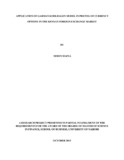| dc.description.abstract | Currency options are derivative financial instruments that are used to hedge against foreign exchange rate exposure. All the international business transactions involve an exchange of one currency for another. Most manufacturers have to import some or all of their raw materials. The cost of production is directly dependent on the prevailing exchange rates. The depreciation of Kenyan shillings leads to increase in cost of materials. Thus firms have to absorb any losses incurred when exchange rates vary. The study therefore, sought to test the applicability of Garman Kohlhagen model in pricing foreign currency options in the Kenyan foreign exchange market. The study used descriptive research design and the Garman Kohlhagen model for pricing of foreign currency options. First, Descriptive statistics and graphical analysis (time series analysis and histograms) were used to determine the trend of the foreign exchange rates and test for normality of the data. The research sought to obtain volatility based on the United States Dollar and Kenya Shillings exchange rates in Kenya for a period of five years between 2010-2014. The study also sought to show how foreign currency options would be priced from the available data. The study used historical data to obtain volatility that together with other variables were plugged into the Garman Kohlhagen model to price the foreign currency options. The study gave findings that were consistent with global studies done in the area of pricing foreign currency options that affirms the suitability of the Garman Kohlhagen model in pricing foreign currency options. The study showed that foreign currency options can be priced in Kenya by use of a Garman Kohlhagen model, the study found out that for call options, when the spot exchange rate is below the strike price, the option has statistically zero value and when above strike price, the option has a positive value. On the other hand, the price of a put currency option is positive when the spot exchange rate is below the strike price and statistically zero when the spot exchange rates are above the strike prices and the further away from the strike price the spot exchange rate is, the higher the value of the option. The study recommended that, the Central Bank of Kenya and the Capital Markets Authority should spearhead faster introduction of an options market in Kenya where options and other derivatives and futures can be traded. The study also, provided suggestions on further research in the areas of pricing currency options under constant volatility. | en_US |

